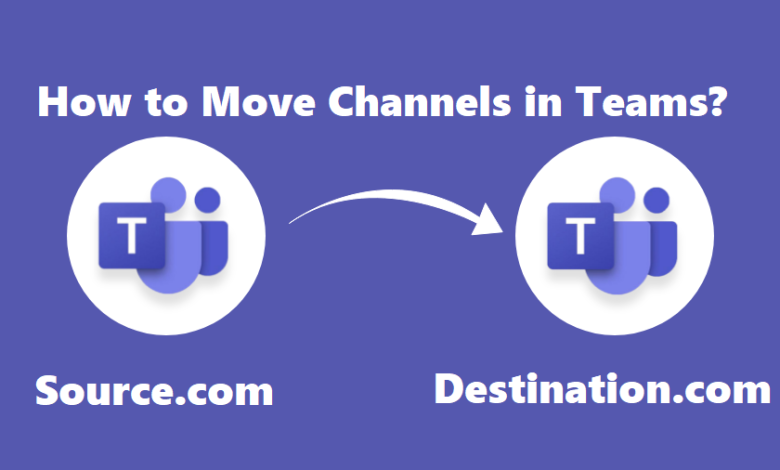How to Move Channels in Teams? Is There Any Genuine Method?

We all are very well aware of the potentials of Microsoft Teams communication & collaboration utility. As a result, organizations are accepting this application due to its lightning speed for business communication. However, there are a large number of questions raised by users around the globe. The most common query that users come up with is “How to Move Channels in Teams”. This article is all about solving this user query.
Due to the core technicalities of Teams & Office 365, IT administrators often get confused in completing this complex work. In this article, we are going to list out some of the severe challenges & then talk about the solution that most users are waiting for. Furthermore, the solutions are discussed in a step-by-step guide to make the process easy to learn. This article provides an excellent overview of Teams data migration process. To clear all severe doubts, read this essay till the end.
Microsoft Teams move conversation to different Channel – The Challenges
There are various limitations that stop users to migrate the private conversations in Teams. However, users can still migrate the chats of Teams Channels & Groups if they have the right knowledge. Here are some of the challenges listed that make the process complex.
Storage Limitations
MS Teams stores its data files at different places like OverDrive, SharePoint sites & Exchange mailbox. This makes the procedure complex as now we have various locations to fetch the data.
API Limitations
There are some sort of API limitations, that hinders users to migrate chats. However, there’s a way to transfer the Teams, Groups, & Channel chats that we’re going to discuss later in this article. This creates a huge barrier when the user wants to transfer Microsoft Teams to a new tenant freely.
No Direct Solution
Microsoft does provide any direct method or utility for its troubled users to execute such complex operations. Naive users without proper knowledge often try some false methods & end up losing their crucial data files. This makes data security a huge concern for businesses.
What’s Optimum Solution to Counter the Challenges?
Users need to opt for the Most Secure Microsoft Teams Migration Tool to migrate data files from one MS Teams to another. We call this technique the modern approach or the automated approach. This tool was created to address all of the process’s present constraints. Furthermore, compared to the manual way, this solution is much faster.
After you’ve downloaded the utility, activate the license key, launch it and then follow the procedures outlined below. This step-by-step tutorial can provide the solution to counter user query “how to move Channels in Teams?”.
Step-1. Choose Office 365 as your primary and secondary platforms.

Step-2. In the category area, select Teams > enable Teams & Channel creation.

Step-3. For both the primary and targeted platforms, provide your Office 365 admin credentials.

Step-4. Using the User Group Mapping function, add and validate users.

Step-5. Manually or using a CSV file, fetch or import Teams.

Step-6. As needed, create Teams for the destination accounts.

Step-7. Click the Validate button and then the Start Migration button to begin the migration process.

Step-8. Once you’ve completed all of the steps, click “Mark Teams as Complete.”

Step-9. Select Fetch Groups or Import Groups from the Groups Tab.

Step-10. Give the desired Groups a destination, approve it, and begin the migration.

Reasons for opting for the Modern Approach
Users must understand the features of the modern approach. This section focuses on the modern solution’s unique traits that make it different from other available options.
- This utility can migrate Microsoft Teams, Groups, Files, Channels, and Channel Chats, among other elements as per users’ preference.
- Microsoft Teams move conversation to different Channel is possible with the help of this teams migration tool.
- The automated solution has a functionality that allows you to move Teams Sites, Links, and Members together with their rights.
- At the destination accounts, there is a feature that automatically creates Teams and Channels as described by the user during migration.
- After migration, the destination accounts keep their folder hierarchy and timestamps intact.
- For migrating recently arrived data, the delta-migration feature is beneficial for users.
- Files and attachments can also be migrated to the destination platforms.
Conclusion
Now, that we are at the end of this article, it’s time for the crisp, short, and unbiased judgment. Many users around the world ask for the solution to this query & get confused due to various false information present on the web. The clear-cut solution is that users must opt for the Modern Solution as discussed above to minimize the risk involved in this process.
Organizations seeking to operate on this migration project must pay special attention to the approach & tool for the data migration. Otherwise, due to the difficulties outlined above, the process can be a complete disaster. Now that we have learned how to move Channels in Teams in a safe manner, it’s on users whether they want a smooth data migration experience or not.




